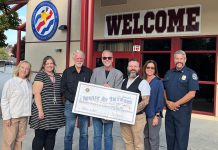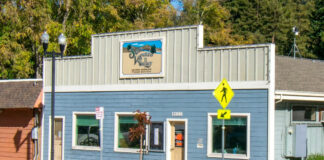Contrary to popular belief, the California Gold Rush was not a two-year affair and was not localized to the Sierra foothills; the lust for gold spread to every corner of the state including the slopes of Ben Lomond Mountain.
In 1853, a lucky farmer named Philip T. Stribling discovered a large gold nugget in what became Gold Gulch south of Felton. The final value of the rock was estimated to be $35,000 — nearly a million dollars in today’s money.
Naturally, this strike sparked a short but fervent gold rush in the Santa Cruz Mountains. For over a decade, small quantities of gold were found on a regular basis. But the gold was largely inaccessible, with thick foliage and temperamental streams denying access to the veins. Those hoping to profit from Santa Cruz gold mostly gave up by the late 1860s.
Three decades passed, during which time Frederick A. Hihn collected outstanding debts from prospectors and slowly bought out the entire Gold Gulch basin.
By 1893, his lumber mill on Valencia Creek in Aptos had run out of available timber and Hihn decided that the vast redwood acreage along Gold Gulch would keep him afloat until the end of the century.
For the next five years, Gold Gulch was transformed into a major lumbering center. A mile of track was extended from the Southern Pacific Railroad’s narrow-gauged branch to downtown Felton to the mill and the timber tracts above it. This switch became known as “Fahihn”, after F.A. Hihn.
The mill, meanwhile, was located near the modern junction of Lakeview Drive and Brookside Way, both of which follow Hihn’s original railroad right-of-way for part of their lengths.
Hihn brought his own private locomotive, the “Betsy Jane,” in from Valencia Creek and harvested all of the old-growth lumber in the Gold Gulch area. Unfortunately, the mill never performed as well as Hihn’s other operations and Hihn decided to cut his losses in 1897. He relocated to Laurel the next year.
After the removal of the railroad tracks in 1906, Gold Gulch returned to a state of nature. Hihn’s family retained control of the land until selling it to the Seminary Avenue Land Company in the spring of 1924. They developed the area into the Forest Lakes residential subdivision. The company planned to dam Gold Gulch and Boulder Brook at regular intervals, thereby creating “lakes”, but only one dam survives today creating the local seasonal swimming hole.
– Derek Whaley is a local historian specializing in the railroading past of Santa Cruz County. For more information, visit his website at http://www.SantaCruzTrains.com.












